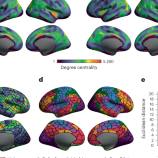
Articles
-
2 months ago |
nature.com | Wenchang Qian |Penglei Jiang |Mingming Niu |Yujuan Fu |Deyu Huang |Dong Zhang | +12 more
DNA methylation is a significant component in proximal chromatin regulation and plays crucial roles in regulating gene expression and maintaining the repressive state of retrotransposon elements. However, accurate profiling of the proteomics which simultaneously identifies specific DNA sequences and their associated epigenetic modifications remains a challenge. Here, we report a strategy termed SelectID (selective profiling of epigenetic control at genome targets identified by dCas9), which introduces methylated DNA binding domain into dCas9-mediated proximity labeling system to enable in situ protein capture at repetitive elements with 5-methylcytosine (5mC) modifications. SelectID is demonstrated as feasible as dCas9-TurboID system at specific DNA methylation regions, such as the chromosome 9 satellite. Using SelectID, we successfully identify CHD4 as potential repressors of methylated long interspersed nuclear element-1 (LINE-1) retrotransposon through direct binding at the 5’ untranslated region (5’UTR) of young LINE-1 elements. Overall, our SelectID approach has opened up avenues for uncovering potential regulators of specific DNA regions with DNA methylation, which will greatly facilitate future studies on epigenetic regulation. The authors introduce SelectID, an approach combining CRISPR-guided targeting with methylation-sensitive labeling to identify proteins interacting with methylated repetitive sequences. They suggest that CHD4 directly binds young LINE-1 retrotransposons, suppressing their activity.
-
Nov 16, 2023 |
nature.com | Chongwen Li |Luke Grater |Zehua Chen |René A. J. Janssen |Gunnar Kusch |Henry J. Snaith | +19 more
Monolithic all-perovskite triple-junction solar cells have the potential to deliver power conversion efficiencies beyond those of state-of-art double-junction tandems and well beyond the detailed-balance limit for single junctions. Today, however, their performance is limited by large deficits in open-circuit voltage and unfulfilled potential in both short-circuit current density and fill factor in the wide-bandgap perovskite sub cell. Here we find that halide heterogeneity—present even immediately following materials synthesis—plays a key role in interfacial non-radiative recombination and collection efficiency losses under prolonged illumination for Br-rich perovskites. We find that a diammonium halide salt, propane-1,3-diammonium iodide, introduced during film fabrication, improves halide homogenization in Br-rich perovskites, leading to enhanced operating stability and a record open-circuit voltage of 1.44 V in an inverted (p–i–n) device; ~86% of the detailed-balance limit for a bandgap of 1.97 eV. The efficient wide-bandgap sub cell enables the fabrication of monolithic all-perovskite triple-junction solar cells with an open-circuit voltage of 3.33 V and a champion PCE of 25.1% (23.87% certified quasi-steady-state efficiency). Wide-bandgap perovskite solar cells are limited by losses in open-circuit voltage. Wang et al. show that diammonium halide salts promote a homogeneous distribution of halides in the perovskite, improving the performance of single- and triple-junction solar cells.
Try JournoFinder For Free
Search and contact over 1M+ journalist profiles, browse 100M+ articles, and unlock powerful PR tools.
Start Your 7-Day Free Trial →